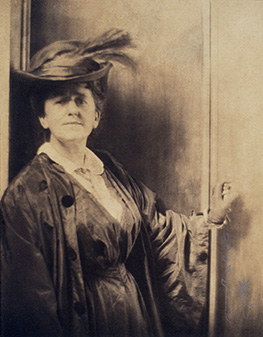A brief biography of Edward Steichen, one of the most influential pioneers of photography on whose shoulders we stand.
“It is rather amusing, this tendency of the wise to regard a print which has been locally manipulated as irrational photography – this tendency which finds an esthetic tone of expression in the word faked. A MANIPULATED print may be not a photograph. The personal intervention between the action of the light and the print itself may be a blemish on the purity of photography. But, whether this intervention consists merely of marking, shading and tinting in a direct print, or of stippling, painting and scratching on the negative, or of using glycerine, brush and mop on a print, faking has set in, and the results must always depend upon the photographer, upon his personality, his technical ability and his feeling. BUT long before this stage of conscious manipulation has been begun, faking has already set in. In the very beginning, when the operator controls and regulates his time of exposure, when in dark-room the developer is mixed for detail, breadth, flatness or contrast, faking has been resorted to. In fact, every photograph is a fake from start to finish, a purely impersonal, unmanipulated photograph being practically impossible. When all is said, it still remains entirely a matter of degree and ability.” – Edward Steichen
In Luxembourg, a small country wedged between Germany, Belgium and France, is the little known Clervaux Castle secluded in the north of the country. It was built in the 12th century but destroyed in the Battle of the Bulge in the Second World War. Since then it has been restored and now houses the town’s administrative offices and a small museum.
The museum contains an exhibition of over 500 photographs collected from photographers in 36 countries that were assembled and first shown in 1955 at the New York Museum of Modern Art. Since its first showing, the exhibition has traveled around the world and has been seen by more than 9 million people. Finally, it was donated to the Grand Duchy of Luxembourg and reached its permanent home in the Castle.
 Éduard Jean Steichen was born on March 27, 1879 to Jean-Pierre and Marie Kemp Steichen in Bivange, Luxembourg. He was still a toddler when his parents moved to the United States and settled in Hancock located in Michigan’s upper peninsula where his father worked in the copper mines. When his father became incapacitated, they moved to Milwaukee. There his mother supported the family by working as a milliner.
Éduard Jean Steichen was born on March 27, 1879 to Jean-Pierre and Marie Kemp Steichen in Bivange, Luxembourg. He was still a toddler when his parents moved to the United States and settled in Hancock located in Michigan’s upper peninsula where his father worked in the copper mines. When his father became incapacitated, they moved to Milwaukee. There his mother supported the family by working as a milliner.
He attended Pio Nono College, a Catholic boys’ high school when he was 15 and was already showing artistic talent in his drawings. But before finishing high school, he dropped out to become a lithography apprentice at the American Fine Art Company of Milwaukee. He continued drawing and took up painting. In 1895 at the age of 16 he bought his first camera, a secondhand Kodak box “detective” camera. Together with several of his friends who also enjoyed photography, they pooled their money to rent a small room in a Milwaukee office building and formed the Milwaukee Art Students League.
Steichen continued drawing and painting, but he also took to photography for which he obviously had an eye. The first showing of his photographs, at the age of 20, was at the Philadelphia Photographic Salon in 1899. In 1900 Steichen exhibited his photographs in the Chicago Salon. It is there that Clarence H. White, one of the leading proponents of Pictorialist photography and a colleague of the legendary Alfred Stieglitz, saw his photographs and was greatly impressed. He decided he had to introduce Steichen to the Stieglitz in New York, the photographer whose lifelong obsession was to establish photography as a legitimate art and the driving force behind the Pictorialist movement in America. White wrote a letter to Stieglitz, telling him of his find. Stieglitz was interested.
Continue reading “Edward Steichen”
(433)
Like this:
Like Loading...


